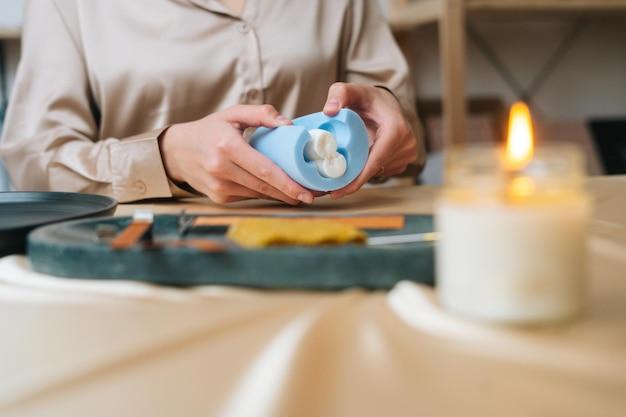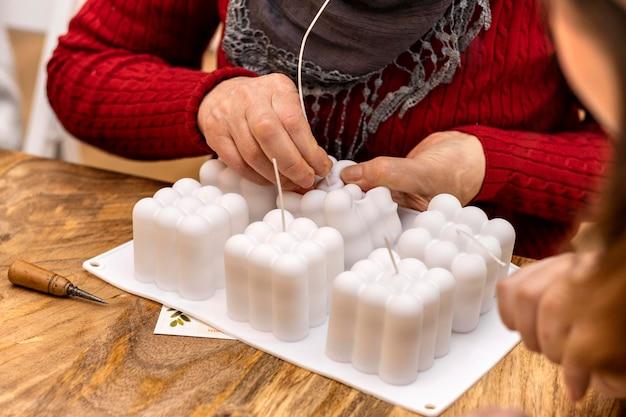Introduction
Welcome to our blog post on what you can use for candle mold release. If you’re a candle-making enthusiast or thinking about starting your own candle-making business, understanding the importance of a good mold release is crucial. In this article, we’ll explore various aspects of candle mold release, including what it is, why you need it, and how to use it effectively.
We’ll also delve into other related topics, such as greasing candle molds, getting candle wax to stick to jars, making your own candle molds, and using resin molds for candles. By the end of this comprehensive guide, you’ll have all the knowledge you need to ensure smooth and successful candle-making adventures. So let’s dive in!
What Can I Use For Candle Mold Release
If you’re an avid candle maker like me, you know the struggle of getting your beautiful wax creations out of their molds. Sometimes they just don’t want to budge! But fear not, my fellow chandlers, because I’ve got some fantastic candle mold release hacks that will make your life so much easier.
Coconut Oil: Nature’s Slippery Secret
Coconut oil isn’t just for cooking and moisturizing your skin. It’s also a fantastic natural candle mold release agent. The high fat content in coconut oil creates a slippery surface that allows the wax to release effortlessly from the mold. Simply melt some coconut oil and brush it onto the inner surface of your mold before pouring in the wax. This will ensure a smooth release every time!
Cooking Spray: A Kitchen Staple Saviors
Ah, the trusty cooking spray! It turns out this kitchen superstar can also come to the rescue in your candle making adventures. Just like with baking, a quick spritz of cooking spray on the inside of your mold will create a non-stick barrier between the wax and the mold. Use a light hand, though, because too much spray can leave your candles feeling greasy.
Parchment Paper: The Savior of Stubborn Stucks
If you’ve ever tried to peel stuck-on wax off a mold, you’ll understand the frustration. But fear not, for parchment paper is here to save the day! Cut out a piece of parchment paper that fits snugly inside your mold and place it before pouring in the wax. When the time comes to release the candle, the parchment paper will help lift it out effortlessly. It’s like magic!
Rubbing Alcohol: The Cleaning Specialist
Now, you might be wondering why I’m bringing up rubbing alcohol in a post about mold release. Well, my friend, the secret lies in its cleaning properties. Sometimes, residual wax can build up on the mold and make it harder for the new candle to release. By wiping the mold with rubbing alcohol before pouring in the wax, you’ll create a clean surface that allows for easy release. Plus, it helps sanitize your mold too!
Freezing Technique: The Cold Beckoning
Let’s face it, sometimes even the best mold release hacks fail us. But fear not, there’s one last trick up my sleeve: the freezing technique. After your candle has hardened in the mold, place the entire mold in the freezer for about 20-30 minutes. The cold temperature will cause the wax to contract slightly, making it easier to pop out of the mold. Just be careful not to freeze it for too long, or you might end up with cracked candles!
So there you have it, my candle-loving friends! These candle mold release hacks will save you from the frustration of stuck candles and let you enjoy the creative process without any pesky mold-related woes. Give them a try and let the wax slide right out with ease. Happy candle making!
Disclaimer: Always test these mold release methods on a small batch or spare mold before using them on your prized candle creations.
FAQ: What Can I Use For Candle Mold Release
How to Grease a Candle Mold
To grease a candle mold, you can use a non-stick cooking spray or rub the inside of the mold with a thin layer of vegetable oil or shortening. This will help the candle easily release from the mold after it has set, ensuring a smooth and beautiful finish.
What is Candle Mold Release
Candle mold release is a substance used to prevent the candle from sticking to the mold. It creates a barrier between the candle and the mold, allowing for easy removal. There are various types of mold release available, including mold release sprays, powders, and waxes.
How to Get Candle Wax to Stick to the Jar
To get candle wax to stick to the jar, make sure the jar is clean and free from any residue. You can also slightly heat the jar before pouring the melted wax to help it adhere better. Additionally, using a hot glue gun to secure the wick at the bottom of the jar can help keep the wax in place.
Can I Make My Own Candle Molds
Yes, you can make your own candle molds! There are various materials you can use, such as silicone, latex, or even household items like empty milk cartons or aluminum cans. Get creative and experiment with different shapes and sizes to make unique and personalized candle molds.
Do You Need Mold Release for Candles
While it is not always necessary, using mold release for candles can make the demolding process much easier. It helps to prevent any damage to the candle or the mold during removal. If you want to achieve a professional-looking candle and ensure easy release, using mold release is highly recommended.
Can I Put Candle Wax in Resin Molds
Yes, you can put candle wax in resin molds. However, it is important to note that resin molds are typically not heat resistant, so pouring hot wax directly into them may cause damage. To safely use resin molds for candles, you can pre-melt the wax and let it cool slightly before pouring it into the molds.
How Long Do Candles Take to Set
The time it takes for candles to set can vary depending on several factors, such as the type and size of the candle and the ambient temperature. Generally, small candles can take anywhere from 2 to 4 hours to set, while larger and more intricate candles may need several hours or even overnight to fully harden.
What Resin is Heat Resistant
When it comes to heat-resistant resins, epoxy resins are generally a good choice. Epoxy resins have excellent heat resistance properties, allowing them to withstand higher temperatures without deforming or melting. This makes them ideal for creating candle molds or embedding candles in resin art projects.
Does Resin Melt with Heat
Yes, resin can melt with heat if exposed to temperatures beyond its heat resistance. Each type of resin has its own heat resistance limit, so it’s important to check the specifications of the specific resin you are using. Excessive heat can cause the resin to soften, warp, or even melt completely.
Can You Fix Wet Spots in Candles
Wet spots, which are small irregularities or air pockets that form between the wax and the container, can be fixed to some extent. One method is to use a heat gun to gently warm the affected area and then press the wax against the container to smooth it out. However, it’s important to note that completely eliminating wet spots can be challenging.
What is Mold Release Wax
Mold release wax is a type of wax specifically designed to aid in the release of objects from molds. It creates a thin layer that prevents the material from sticking to the mold. Mold release wax is commonly used in various industries, including candle making, to ensure easy and clean removal of the final product from the mold.
How Long Do Plastic Molds Last
The lifespan of plastic molds can vary depending on the quality of the material and the frequency of use. Generally, plastic molds can last for multiple uses if properly cared for and cleaned after each use. However, over time, plastic molds may become worn or develop small cracks, which can affect their effectiveness.
What Does Candle Wax Not Stick To
Candle wax is known for its ability to stick to various surfaces, but there are a few materials it typically does not adhere to. These include silicone, certain types of plastics, and smooth metals such as aluminum or stainless steel. Using molds made from these materials can make the demolding process much easier.
Can You Use Plastic for Candle Molds
Yes, plastic can be used for candle molds. Plastic molds are widely available and are a popular choice among candle makers due to their durability and affordability. They come in a variety of shapes and sizes, making it easy to find the perfect mold for your candle-making needs.
Can You Make Candle Jars Out of Epoxy
Yes, it is possible to make candle jars out of epoxy. Epoxy is a versatile material that can be used to create custom candle containers in various shapes and designs. However, it’s important to ensure that the epoxy is heat resistant, or else the candle jar may deform or melt when exposed to heat.
Why is Resin Added to Hot Wax
Resin is sometimes added to hot wax to enhance its fragrance, color, or durability. Resin can act as a fixative, helping the scent to last longer in the candle. It can also add a glossy finish to the wax and provide additional strength and resistance to the finished candle.
What Can Go Wrong When Making Candles
Several things can go wrong when making candles, such as uneven burning, tunneling, poor scent throw, or wick-related issues. Inadequate temperature control during the melting and pouring process can also result in issues like cracking or frosting of the wax. Proper preparation, use of quality materials, and careful attention to detail can help avoid these common candle-making mishaps.
How to Make Your Own Candle Molds
Making your own candle molds can be a fun and creative process. There are several methods you can try, including using silicone putty to mold existing objects, creating a mold using silicone or latex, or even using household items like empty containers. Experimentation and imagination are key to producing unique and personalized candle molds.
What Can I Use as a Candle Holder
When it comes to candle holders, there is a wide range of options to choose from. Common choices include glass candle holders, metal candle holders, ceramic candle holders, or even wooden candle holders. You can also get creative and use unconventional items like seashells, mason jars, or vintage teacups to add a unique touch to your candle display.
What Material is Best for Candle Molds
The best material for candle molds depends on various factors, including the type of candle you’re making, your budget, and personal preference. Popular choices include silicone, latex, metal, or plastic molds. Each material has its own advantages and considerations, so it’s a matter of finding the one that suits your specific needs and preferences.
Does Wax Melt in Resin
Yes, wax can melt when in contact with resin. Depending on the temperature and duration of exposure, the resin can melt the wax or cause it to become soft and deform. It’s important to consider the heat resistance of the resin and take precautions when combining wax and resin in projects to avoid undesired results.

